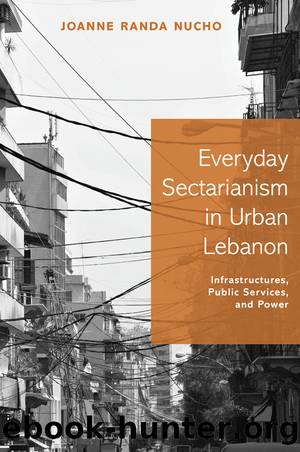Everyday Sectarianism in Urban Lebanon by Nucho Joanne Randa

Author:Nucho, Joanne Randa. [Nucho, Joanne Randa.]
Language: eng
Format: epub
ISBN: 9780691168975
Publisher: PrincetonUP
Published: 2016-07-15T05:00:00+00:00
DEVELOPING âGOODâ WOMEN, PROGRESS THROUGH THE NETWORK
Silvart, an energetic woman in her late fifties, had spent most of her life working in Bourj Hammoud, though she and her family lived in a middle-class suburb nearby. During the long, dark years of the civil war, Silvart had begun her career as a coordinator between various international charities and the prelacy of the Lebanese branch of the Armenian Apostolic Church, which runs several schools and churches in the area. In those days her work was focused on emergency and relief services. Like many of my interlocutors in Bourj Hammoud, Silvart had harrowing tales of the war. A constant barrage of shells falling close enough for her to hear the whizzing sound of their flight through the air, one blowing up her car just in front of her house, militiamen overrunning and claiming her familyâs shop in a nearby neighborhoodâall these were stories she related during our conversations. And yet Silvart also echoed another popular sentiment Iâd heard through many of my interviews about Bourj Hammoud during the warâone of nostalgia.
âDuring the war, people knew who they really were,â Silvart said. Ultimately, Silvart thought, âbeing Armenianâ was the only recourse for safety, for stability, for a sense of community and solidarity for an Armenian in Lebanon. There were various ways for women to demonstrate their commitment to being Armenian. One of them was sending oneâs children to the Armenian schools in Bourj Hammoud or elsewhere. While lower-income families were more likely send their children to Armenian schools, particularly with the assistance of arachnortaran scholarships and subsidies for Armenian students, Silvart suggested that wealthy Armenians seem to have âforgotten their rootsâ and send their children to exclusive Lebanese Christian academies that do not offer any instruction in Armenian language or history. She noted, sardonically, that the next time Lebanon was enveloped in a violent, cataclysmic war (an inevitability, she thought), these people would be faced with the reality that they are first and foremost Armenians, and only other Armenians can offer them the protection and security that is so elusive in times of conflict.
Silvartâs lifelong work has been to support and maintain the âcommunity,â a task that, ironically, has only become more difficult since the civil war in Lebanon ended in 1990. During the war the needs were obvious, and it was easier to attract international assistance. Now, however, despite the economic and political instability that has plagued the country ever since the war ended, it is much harder to attract aid. Silvart enthusiastically listed all the economic development projects for women that she had been involved with since 2000. Two of the projects, a catering business and a job placement service, were illustrative of the types of enterprises that the Tashnag-dominated arachnortaran had embarked on that serve mainly Armenian women. The catering business employed Armenian women who lived in the Bourj Hammoud area. Specializing in Armenian and Lebanese dishes like manti (meat dumplings) or kibbet laqteen (pumpkin croquettes), the business maintained a food delivery service with a menu that changed daily.
Download
This site does not store any files on its server. We only index and link to content provided by other sites. Please contact the content providers to delete copyright contents if any and email us, we'll remove relevant links or contents immediately.
| Africa | Americas |
| Arctic & Antarctica | Asia |
| Australia & Oceania | Europe |
| Middle East | Russia |
| United States | World |
| Ancient Civilizations | Military |
| Historical Study & Educational Resources |
The Battle of Mogadishu by Matt Eversmann & Dan Schilling(723)
The Confidence Men by Margalit Fox(672)
The Spymaster of Baghdad by Margaret Coker(643)
A History of the Muslim World since 1260: The Making of a Global Community by Vernon O. Egger(642)
Jack the Ripper and the East End by Peter Ackroyd(610)
Empire of Fear: Inside the Islamic State by Andrew Hosken(589)
The Afghanistan File by Prince Turki AlFaisal Al Saud(586)
The Crimean War by Winfried Baumgart(579)
Islam At The Gates: How Christendom Defeated the Ottoman Turks by Diane Moczar(574)
The Jerusalem Diamond by Noah Gordon(568)
Akhenaten by Dominic Montserrat(566)
A Concise History of Greece (Cambridge Concise Histories) by Richard Clogg(554)
Beirut 2020 by Charif Majdalani(554)
The History of Jihad by Robert Spencer(550)
Enemy in the East by Rolf-Dieter Müller(533)
Israel: Ancient Kingdom or Late Invention? by Daniel I. Block(532)
The Privatization of Israeli Security by Shir Hever(527)
The Nine Lives of Pakistan by Declan WALSH(522)
Destroying a Nation: The Civil War in Syria by Nikolaos van Dam(516)
